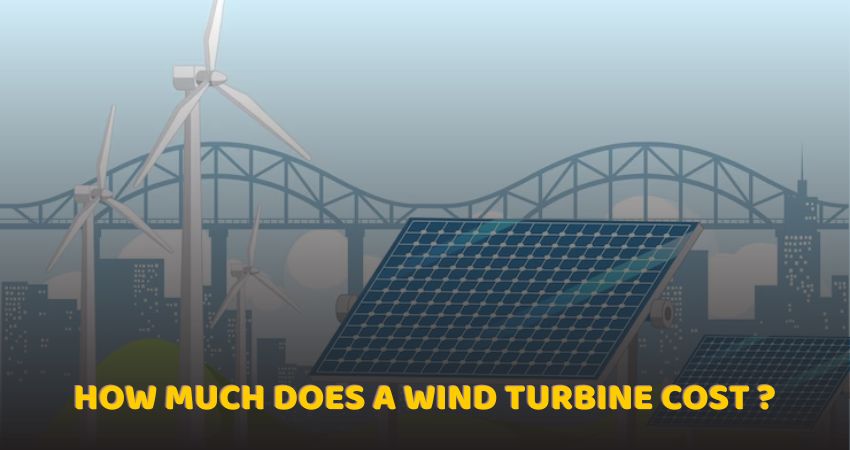Table of Contents
Introduction
Wind power distinguishes itself as a genuine and sustainable option among renewable energy sources.
People’s interest in employing wind turbines to produce electricity has increased recently. But many individuals are curious about how much a wind turbine will cost to build and maintain. In this post, we’ll look at the variables that affect wind turbine costs and give a few basics on associated costs.
Understanding the Basics of Wind Turbines
Large constructions called wind turbines have blades that collect wind energy and turn it into electricity. They consist of various components, including the tower, nacelle, rotor, and generator. The tower provides support and height, allowing the turbine to access stronger and more consistent winds at greater heights.
Factors Affecting a Wind Turbine’s Price
Several factors influence the cost of a wind turbine:
Turbine Size and Capacity
The size and capacity of a wind turbine directly affect its cost. Larger turbines with higher capacity can generate more electricity but often come at a higher price. Manufacturers offer a range of turbine sizes to suit different energy needs and site conditions.
Location and Wind Resources
The location of a wind turbine plays a crucial role in determining its cost. Wind resource assessment is essential to identify areas with optimal wind conditions. Turbines installed in high-wind areas are more productive but may require additional structural reinforcement, impacting the overall cost.
Installation and Maintenance
The installation and maintenance costs of a wind turbine include transportation, assembly, and ongoing servicing. These costs may differ based on the project’s intricacy, site accessibility, and the requirement for specialised tools and labourers.
Grid Connection
Connecting a wind turbine to the electrical grid involves additional costs. It requires infrastructure development, such as transformers and transmission lines, to facilitate the transfer of generated electricity. Distance to the grid and connection requirements can impact the expenses associated with grid connection.
Cost Breakdown of a Wind Turbine
To better understand the cost components of a wind turbine, let’s break it down:
Turbine Manufacturing
The manufacturing cost includes the production of turbine components, such as blades, tower, and nacelle. It involves raw materials, labor, quality control, and transportation. Manufacturing costs vary among turbine models and manufacturers.
Site Preparation
Preparing the site for a wind turbine involves land leasing, permits, environmental impact assessments, and geotechnical studies. These initial steps ensure a suitable location and comply with regulatory requirements.
Installation and Construction
Installation costs encompass transportation of turbine components to the site, foundation construction, tower erection, and assembly of the rotor and nacelle. This phase demands skilled labor, specialized equipment, and adherence to safety standards.
Operation and Maintenance
Operating and maintaining a wind turbine involve regular inspections, lubrication, component replacement, and troubleshooting. These activities ensure optimal performance and longevity of the turbine. Certainly! Here’s the continuation of the article:
Grid Connection
Grid connection costs include the infrastructure needed to connect the wind turbine to the electrical grid. This involves the installation of transformers, power lines, and substation equipment. The distance between the turbine and the grid, as well as any necessary upgrades to the existing grid infrastructure, can impact the overall cost.
Financing Options for Wind Turbines
Investing in a wind turbine can require a significant upfront cost. However, there are various financing options available to make it more accessible. Some common financing methods include:
Outright Purchase: This involves purchasing the wind turbine and associated components directly, either through personal funds or loans.
Leasing: Leasing allows individuals or businesses to rent a wind turbine and pay regular installments. This option can reduce upfront costs and provide flexibility.
Power Purchase Agreements (PPAs): PPAs entail making agreements with energy suppliers or utility companies to buy the power produced by the wind turbine at a predetermined price.
Government Incentives and Grants: Many governments offer incentives and grants to promote renewable energy. These can assist offset the initial investment and include tax credits, feed-in tariffs, and subsidies.
Return on Investment for Wind Turbines
The initial cost, generation of electricity, maintenance costs, and current energy prices are some of the factors that affect a wind turbine’s return on investment (ROI). A wind turbine can produce power while decreasing the cost of traditional energy sources for 20 to 25 years, depending on the model. The ROI period can vary, but with proper planning and efficient operation, wind turbines can provide long-term financial benefits.
Future Trends and Cost Reduction Strategies
The wind energy industry is continually evolving, with advancements aimed at reducing the cost of wind turbines. Some of the trends and strategies contributing to cost reduction include:
Technological Innovations: Ongoing research and development lead to improved turbine designs, materials, and manufacturing processes, making wind turbines more efficient and cost-effective.
Scaling up: Larger turbines with higher capacity are being developed to capture more wind energy, which can increase energy production and reduce costs per unit of electricity generated.
Increased Competition: As the wind energy market expands, competition among turbine manufacturers increases. This competition can drive innovation and lower prices.
Improved Maintenance Techniques: Advanced maintenance strategies, such as predictive analytics and remote monitoring, help optimize maintenance schedules, minimize downtime, and reduce operational costs.
FAQs
Can wind turbines be installed in urban areas?
Are there any incentives or grants available for installing a wind turbine?
Are there any ongoing costs associated with owning a wind turbine?
Conclusion
When making a wind turbine investment, it’s crucial to carefully consider a number of different facets, like the cost of ownership, going on maintenance costs, and prospective returns. Size, location, setup, and grid connection are just a few of the elements that affect how much a wind turbine costs. However, wind power is becoming more readily available and affordable due to financing choices, government incentives, and technology breakthroughs. Wind turbines are essential to the shift to a more environmentally friendly future as humanity looks for renewable energy alternatives.


Your article helped me a lot, is there any more related content? Thanks!